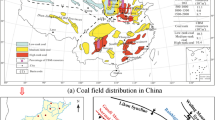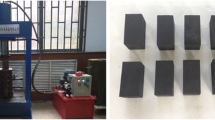Abstract
The present paper focuses on the mechanical properties, permeability and energy variation within gas contained bump-prone coal, and, based on theoretical and experimental methods, the paper seeks to elucidate the complex mechanical mechanism of gas emissions with gradually varying states of stress and its catastrophic mechanisms. A triaxial test apparatus is developed specifically for stressed coal, taking the properties of gas adsorption and migration into consideration under stress conditions and providing simultaneous measurement of deformation and gas flux. The entire deformation process of coal samples with a danger of bump, obtained from a depth of 580 m in the Xinzhouyao colliery of northern China, was investigated by conventional triaxial compression experiments using various levels of confining pressure and gas. Sieve analysis was used to measure the post-failure coal fragments, and an empirical formula was developed to describe the new surface during coal failure. It was found that the existence of gas reduces cohesion and increases the internal friction angle, the strength decreases with increasing gas pressure, and the elastic modulus is gradually reduced by the influence of confining pressure. The angle of coal damage increases from the failure model of conjugate shear to single shear and tension shear with larger fractal dimensions. Permeabilities showed clear phase characteristics with coal deformation, and the theoretical analysis revealed that the gas energy is mainly derived from free gas in the fissures. With higher gas pressures and porosities of coal, larger amounts of energy were contained in the coal seams. As a consequence, the energy composition has a direct impact on disaster types, initiation and occurrence. A surplus energy evolution model and disaster tendency evaluation index for coal failure was developed and used to determine the instability type. These test results may help us gain insight into the mechanical coupling mechanism between coal and gas, even in deep mining where high in situ stresses and gas pressures may cause bump-outburst compound disasters.

















Similar content being viewed by others
References
Alexeev AD, Feldman EP, Vasilenko TA (2000) Alteration of methane pressure in the closed pores of fossil coals. Fuel 79:939–943
BadrulAlam AKM, Niioka M, Fujii Y, Fukuda D, Kodama J-i (2014) Effects of confining pressure on the permeability of three rock types under compression. Int J Rock Mech Min Sci 65(1):49–61
Balaji Rao K, Anoop MB (2013) Why do we need probability distributions with fat tails to describe the surface strain evolution in reinforced concrete flexural members? Meccanica 48:1517–1542
Beranbe Y, Mok U, Evans B (2003) Permeability-porosity relationships in rocks subjected to various evolution processes. Pure Appl Geophys 160:937–960
Cai M (2008) Influence of intermediate principal stress on rock fracturing and strength near excavation boundaries—insight from numerical modeling. Int J Rock Mech Min Sci 45:763–772
Cai Y, Liu D, Mathews JP, Pan Z, Elsworth D, Yao Y, Li J, Guo X (2014) Permeability evolution in fractured coal — combining triaxial confinement with X-ray computed tomography, acoustic emission and ultrasonic techniques. Int J Coal Geol 122:91–104
Cao SG, Luo F, Liu YB, Li Y, Guo P, Li GD (2016) Gas migration of coal in front of a mining face considering crack evolution. Environ Earth Sci 75:1282
Cheng Y, Qingquan L, Tingxiang R (2017) Coal mechanics. Science Press.
Connell LD, Lu M, Pan Z (2010) An analytical coal permeability model for tri-axial strain and stress conditions. Int J Coal Geol 84:103–114
Danesh NN, Chen Z, Connell LD, Kizil MS, Pan Z, Aminossadati SM (2017) Characterisation of creep in coal and its impact on permeability: an experimental study. Int J Coal Geol 173:200–211
Ding X, Xiao-chun X, Xiang-feng L, Wu D, Wang L, Yu-feng F (2018) Investigate on the fractal characteristics and acoustic emission of coal fracture. J China Coal Soc 43(11):3080–3087
Ding X, Xiao X-c, Wu D, Lv X-f (2019) Mechanical properties and charge signal characteristics in coal material failure under different loading paths. Int J Coal Sci Technol 6(1):138–149
Dou LM, He XQ (2001) Theory and technology of rock burst prevention, China. University of Mining and Technology Press, Xuzhou, pp 82–83
Durucan S, Edwards JS (1986) The effects of stress and fracturing on permeability of coal. Min Sci Technol 3:205–216
Espinoza DN, Vandamme M, Dangla P, Pereira J-M, Vidal-Gilbert S (2013) A transverse isotropic model for microporous solids: application to coal matrix adsorption and swelling. J Geophys Res Solid Earth 118:6113–6123
Espinoza DN, Pereira JM, Vandamme M, Dangla P, Vidal-Gilbert S (2015) Desorption-induced shear failure of coal bed seams during gas depletion. Int J Coal Geol 137:142–151
Fowler RH (1935) A statistical derivation of langmuir’s adsorption isotherm. Math Proc Camb Philos Soc 31(2):260–264
Gamson PD, Basil Beamish B, Johnson DP (1993) Coal microstructure and micropermeability and their effects on natural gas recovery. Fuel 72:87–99
Gangi AF (1978) Variation of whole and fractured porous rock permeability with confining pressure. Int J Rock Mech Min Sci Geomech Abstr 15:249–257
Ghabezloo S, Sulem J, Saint-Marc J (2009) Evaluation of a permeability–porosity relationship in a low-permeability creeping material using a single transient test. Int J Rock Mech Min Sci 46:761–768
Gibowicz SJ, Kijko A (1994) An introduction to mining seismology. Academic Press, San Diego, pp 22–23
Gray I (1980) The mechanism of, and energy release associated with outbursts, the occurrence and control of outbursts in coal mines Symp. The Australian I.M.M. Southern Queensland Branch 111–125.
Guo C-y, Xue-fu X, Wu X-h, Wei-jing Y, Chang-yong Z (2009) The relationship among rock crushing energy, the protodyakonov coefficient and rock strength. J Chongqing Jianzhu Univ 30(6):28–31
Harpalani S, Chen G (1997) Influence of gas production induced volumetric strain on permeability of coal. Geotech Geol Eng 1997(15):303–325
He MC, Wang CG, Feng JL, Li DJ, Zhang GY (2010) Experimental investigations on gas desorption and transport in stressed coal under isothermal conditions. Int J Coal Geol 83:377–386
Hobbs DW (1964) The strength and the stress-strain characteristics of coal in triaxial compression. J Geol 72(2):214–231
Jaeger JC, Cook NGW (1979) Fundamentals of rock mechanics, 3rd edn. chapman and hall, London
Katz AJ, Thompson AH (1985) Fractal sandstone pores: implication for conductivity and pore formation. Phys Rev Lett 54(12):1325–1332
Klinkenberg L J (1941) The permeability of porous media to liquids and gases. In: Drilling and production practice. American Petroleum Institute 200–13
Kou S, Dongying YE, Yansheng DING (1990) A constitutive model for structured coal based on fracture and damage mechanics. Eng Fract Mech 35(415):835–843
Lawn B (2009) Fracture of brittle solids: 2nd edition. Cambridge University Press & Higher Education Press.
Levine JR (1996) Model study of the influence of matrix shrinkage on absolute permeability of coal bed reservoirs. Geol Soc Lond Spec Publ 109(1):197–212
Liu J, Chen Z, Elsworth D, Miao X, Mao X (2011) Evolution of coal permeability from stress-controlled to displacement-controlled swelling conditions. Fuel 90:2987–2997
Luo J, Gun H, Yangtao X, Long Z (2016) Experimental study on the relationship between the distribution of micro coal particles and the crushing energy. J China Coal Soc 41(12):3054–3061
Mandelbert BB (1982) The fractal geometry of nature. W H Freeman, New York
Nazridoust K, Ahmadi G, Smith DH (2006) A new friction factor correlation for laminar, single-phase flows through rock fractures. J Hydrol 329:315–328
Noiriel C, Gouze P, Bernard D (2004) Investigation of porosity and permeability effects from microstructure changes during limestone dissolution. Geophys Res Lett 31:L24603
Ogieglo K, Lubryka M, Kutkowski J (2005) The influence of mine shock to gas emission rate. Ground Pressure Strata Control 2:109–111
Pan Y (2016) Integrated study on compound dynamic disaster of coal-gas outburst and rockburst. J China Coal Soc 41(1):105–112
Pan YS, Zhang MT, Xu BY (1996) The analysis of rockburst in coalmine. J Coal Sci Eng 2(1):32–38
Pan YS, Li ZH, Zhang MT (2003) Distribution, type, mechanism and prevention of rockbrust in China. Chin J Rock Mech Eng 22(11):1844–1851 (in Chinese)
Pan Z, Connell LD, Camilleri M, Connelly L (2010) Effects of matrix moisture on gas diffusion and flow in coal. Fuel 89:3207–3217
Peng R, Yang J, Wang JG, Xie H, Gao F, Mao L (2015) Energy dissipation and release during coal failure under conventional triaxial compression. Rock Mech Rock Eng 48:509–526
Perera MSA, Ranjith PG, Choi SK, Airey D (2012) Investigation of temperature effect on permeability of naturally fractured black coal for carbon dioxide movement: an experimental and numerical study. Fuel 94:596–605
Perfect E (1997) Fractal models for the fragmentation of rocks and soils: a review. Eng Geol 48(3–4):185–198
Saurabh S, Harpalani S, Singh VK (2016) Implications of stress redistribution and rock failure with continued gas depletion in coalbed methane reservoirs. Int J Coal Geol 162:183–192
Shi J, Durucan S, Shimada S (2014) How gas adsorption and swelling affects permeability of coal: a new modelling approach for analysing laboratory test data. Int J Coal Geol 128–129:134–142
Shkuratnik VL, Filimonov YL, Kuchurin SV (2005) Regularities of acoustic emission in coal samples under triaxial compression. J Min Sci 41(1):44–52
A. Skochinsky, V. Komarov. Mine ventilation. MIR Publishers, Moscow, U.S.S.R., 1969.
Tie L, Meifeng C (2008) The mechanism of earthquake-induced gas disaster nucleation in coal mines. J China Coal Soc 33(10):1112–1116
Valliappan S, Zhang W (1999) Role of gas energy during coal outbursts. Int J Numer Methods Eng 44:875–895
Wang Z, Guangzhi Y, Hu Q, Hu J (2010) Inducing and transforming conditions from rockburst to coal gas outburst in a high gassy coal seam. J Min Saf Eng 27(4):572–576
Wang K, Feng D, Zhang X, Liang W, Xin C (2017) Mechanical properties and permeability evolution in gas-bearing coal–rock combination body under triaxial conditions. Environ Earth Sci 76:815
Xiaojun C, Marc Bustin R, Dipple G (2004) Selective transport of CO2, CH4, and N2 in coals: insights from modeling of experimental gas adsorption data. Fuel 83:293–303
Xie HP (1993) Fractal in rock mechanics. A. A. Balema Publishers, Rotterdam
Xie HP, Zhou HW (2008) Application of fractal theory to top-coal caving. Chaos, Solitons Fractals 36(4):797–807
Xue DJ, Zhou HW, Chen CF, Jiang YD (2015) A combined method for evaluation and prediction on permeability in coal seams during enhanced methane recovery by pressure relieved method. Environ Earth Sci 73:5963–5974
Yang Y, Aplin AC (2010) A permeability–porosity relationship for mudstones. Mar Pet Geol 27:1692–1697
Zhang X, Zhu S, Xiao L, Shouding L, Jianming H (2011) Study of relationship between poisson’s ratio and angle of internal friction for rocks. Chin J Rock Mech Eng 30(S1):2599–2609
Funding
This work was supported by The National Key Research and Development Program of China (No. 2017YFC0804208), The National Natural Science Foundation of China (Nos. 51774164,969 51974186, 51974147) and The Liaoning Provincial Department of education project - young scientific and technological talents breeding project (LJ2020QNL001).
Author information
Authors and Affiliations
Corresponding author
Ethics declarations
Conflict of interest
The authors declare no competing interests.
Additional information
Responsible Editor: Murat Karakus
Rights and permissions
About this article
Cite this article
Ding, X., Xiao, X., Lv, X. et al. Experimental investigation of mechanical properties, permeability and catastrophic mechanisms of gas contained bump-prone coal. Arab J Geosci 14, 1068 (2021). https://doi.org/10.1007/s12517-021-07369-9
Received:
Accepted:
Published:
DOI: https://doi.org/10.1007/s12517-021-07369-9




